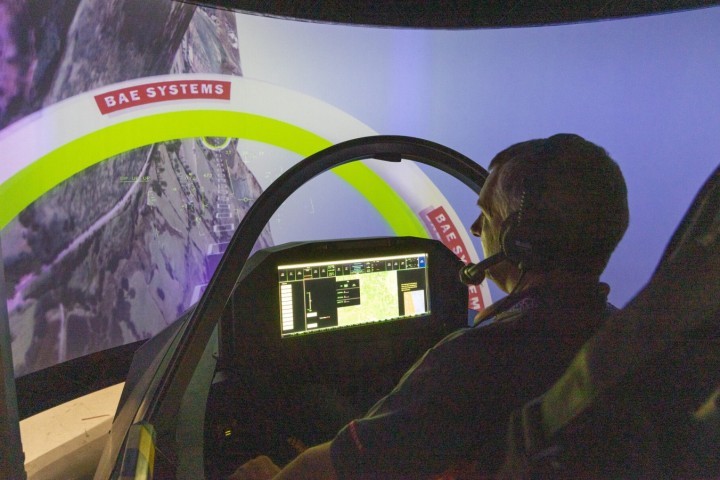Five Hanger sits deep inside British Aerospace’s Warton facility. From the outside there’s little to distinguish it from the myriad of buildings that make up the plant but inside expert engineers are at work delivering the future.
The UK’s major combat air industry partners, including BAE Systems, are on a mission to create the nation’s first flying combat air demonstrator for a generation, with much of the activity taking place on the banks of the Ribble.
The Flying Technology Demonstrator, first announced by the government in 2022, is set to take to the air within the next four years as a vital part of the project to produce the UK’s next generation supersonic stealth combat aircraft, Tempest.
It is being designed using a range of innovative digital techniques and transformative processes, with Lancashire engineers playing a leading role in its development.
The project is also being used to pass on the skills needed for the UK to remain a global leader in defence and aerospace capability and to capture the imagination of young people that will help recruit the next generation of engineers. It has been described as the UK industry “building up its muscle mass.”
Work on the demonstrator continues to gather pace and the progress being made on several fronts was revealed at a media briefing held at Warton in June. A significant proportion of future development work is set to take place in the county.
Inside the cavernous Five Hanger, 10 test pilots from the defence giant, Rolls-Royce and the Royal Air Force have already flown more than 150 hours of the demonstrator aircraft in a new bespoke simulator, providing crucial evidence to support flight trials.
In a first for military aircraft design, BAE Systems’ engineers based in Five Hanger have used auto coding to create safety-critical systems software in a matter of days rather than weeks.
This allows rapid assessment of the flight control systems during more complex flight manoeuvres, with the simulator capturing “crucial data” about how the jet will handle and perform, years before its first flight.
Steve Formoso, head of flying at BAE Systems, is one of the 10 test pilots who have taken the controls, flying the simulator over mocked-up landscapes of the UK. He explained the team regularly comes together to discuss and give constant feedback on the system. He added: “It is developing all the time.”
Jon Wignall, one of the senior BAE Systems test and evaluation engineers involved this part of the project, said: “It is a lot more than a video game.
“When you drive a car people can drive very smoothly or very aggressively. Pilots are very similar. The flight control system must be able to cope with all the different flying styles.”
He says of the development work being carried out: “It is challenging and stretching but we are making it work and we are learning a lot.”
The simulator is just one part of the picture.
Experts from BAE Systems, Rolls-Royce, Leonardo UK, MBDA and the Ministry of Defence (MoD) are collaborating with a range of SMEs to develop the technologies needed to deliver Tempest.
Engineers have been carrying out aerodynamic engine testing, harnessing new advanced manufacturing processes to produce an engine duct, made at BAE Systems’ Samlesbury plant. It is uniquely shaped to slow the air from supersonic to sub-sonic speeds at the engine face.
The intake has fewer moving parts than a traditional fighter jet, enhancing the aircraft’s ‘stealthy’ design. The test on it was conducted at Rolls-Royce’s site in Filton, Bristol, in the same facility where the Concorde Olympus engine was tested in the 1960s.
In another development, working alongside UK crew escape specialist Martin Baker, a team of BAE Systems engineers have led successful ejection seat trials, using a rocket-propelled sled travelling at speeds of more than 500mph.
Experienced engineers have worked alongside junior team members on this project to pass on skills and knowledge which can be taken forward into future developments of Tempest, with the aim of the sixth generation fighter entering service by 2035.
The project partners say the range of “novel technologies” being harnessed by the demonstrator programme will demonstrate and test key elements of the next generation combat air design.
It will also show the skills, tools, processes and techniques needed to develop Tempest, which will be delivered through the Global Combat Air Programme, in partnership withthe UK, Italy and Japan.
The demonstrator is, for the moment, a UK project. But talks are taking place with the view to bringing these new global partners into the development work.
Neil Strang, Tempest programme director at BAE Systems, stressed the significance of the project for the UK, economically and in air defence terms.
He said: “It’s now 40 years since our people led the demonstrator aircraft programme which gave birth to Typhoon and the work we’re doing today is another once-in-a-generation opportunity to write the next chapter in aviation history.
“Right across the Tempest programme we’re using digital techniques and innovative design and engineering methods to ensure we can deliver Tempest in service by 2035.
“We already have 1,000 people involved in this programme across UK industry and the supply chain, with young apprentices and graduates working alongside some of our most experienced engineers.
“This work will continue to act as a beacon, attracting the very best talent and experience to pass on to future generations of engineers needed for the UK to remain an industry leader in defence and aerospace capability.”
Commodore Martin Lowe, director of the programme for the MoD, explained that UK’s previous demonstrator, which led to the Eurofighter Typhoon project, inspired him into a career in the RAF.
He added: “I’d like this supersonic demonstrator aeroplane to have the same impact on another generation.”
Richard Berthon, director future combat air for the MoD, said: “The Flying Demonstrator programme is a remarkable effort to design and build a supersonic stealth jet that will prove integration and develop our national skills, while providing data and learning in support of Tempest entering service by 2035.
“Tempest is no longer just an idea or concept on a computer; our industry partners have made real, tangible progress and are bringing the programme to life through innovative projects, such as the flying demonstrator.”
Enjoyed this? Read more from Ged Henderson























